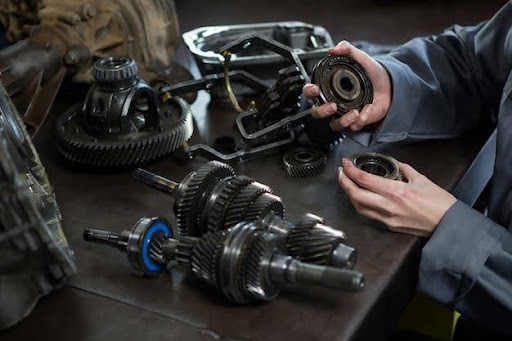
Japanese Production Capacity Now the Right Size
 |
| Toyota is still the largest auto producer in Japan. Workers (above) put the finishing touches on Lexus LS300’s coming down the line at the Tahara assembly plant. |
Since spring 2000, eight plants and two final assembly lines have been closed. One, perhaps two more are being targeted by early 2005. Combined capacity cuts to date: 1.8 million units, representing a nearly 15 percent reduction of installed capacity from levels of three years ago to 11 million units and lowering excess capacity from 30 percent to around 10 percent. Production last year rose 5 percent to 10.3 million units, although the five-year average from 1998 is 10 million.
Included among the closures: Aichi Machine Industry Co.’s Nagoya plant (100,000 units), Kanto Auto Works Ltd.’s Yokusuka plant (180,000 units), Mitsubishi Motors’ Oye (228,000 units), Nissan Motor’s Murayama and No. 1 Kyushu plants (450,000 and 360,000 units), Nissan Shatai Co.’s Kyoto plant (120,000 units), Press Kogyo Co.’s Fujisawa plant (72,000 units) and Takada Kogyo Co.’s Yokohama plant (30,000 units). Meanwhile, Honda Motor shut down its No. 2 assembly line at Suzuka (200,000 units), while only marginally boosting capacity with the overhaul of the now 34-year old Suzuka No. 1 line, and Mitsubishi consolidated four Mizushima assembly lines into three (90,000 units). Scheduled for closure early next year is Isuzu Motors’ Kawasaki truck plant with capacity of 25,000 units.
Mazda Motor, which temporarily closed its Hiroshima-Ujina No. 2 line (220,000-unit capacity), is scheduled to reopen the facility in 2004. Against this backdrop, Suzuki Motor added a third final assembly line in Kosai, boosting installed capacity at its main assembly plant to an estimated 570,000 units, a net gain of 120,000. Making extensive use of overtime, management projects output of 670,000 units this year.
Analysts feel that current capacity is almost the right size for the industry, given the steady offshore shift of production since the mid-1980s and consequent drop in exports. And while the past six years have seen a slightly recovery in export volumes (averaging 4.4 million per year), analysts feel that by the end of the decade exports will settle below 4 million units, meaning production is likely to fall to 9.5 million or slightly lower.
2002 OUTPUT BY MANUFACTURER (in units)
| Toyota | 3,485,000 (+3.9%) |
| Nissan | 1,392,000 (+9.6%) |
| Honda | 1,387,000 (+8.0%) |
| Suzuki | 1,000,000 (+10.2%) |
| Mitsubishi | 871,000 (+4.4%) |
| Mazda | 773,000 (+6.1%) |
| Daihatsu | 600,000 (-6.2%) |
| Fuji | 436,000 (-5.7%) |
| Isuzu | 231,000 (+6.8%) |
| Hino | 54,000 (+1.4%) |
| Nissan Diesel | 27,000 (+10.8%) |
| Total | 10,258,000 (+4.9%) |
2002 OUTPUT BY PLANTS (in units)
| Output | Capacity* | |
| Toyota City (Araco Corp.) | 131,400 | 150,000 |
| Sagamihara (Central Motor) | 90,000 | 80,000 |
| Maebashi (Daihatsu Auto Body) | 133,000 | 144,000 |
| Ikeda (Daihatsu Motor) | 240,000 | 360,000 |
| Kyoto (Daihatsu) | 132,000 | 192,000 |
| Shiga (Daihatsu) | 204,000 | 204,000 |
| Ohta (Fuji Heavy) | 150,700 | 297,000 |
| Yajima (Fuji) | 285,300 | 316,000 |
| Hamura (Hino Motors) | 165,000 | 155,000 |
| Hino (Hino) | 42,900 | 80,000 |
| Sayama (Honda) | 550,900 | 550,000 |
| Suzuka (Honda) | 572,800 | 500,000 |
| Utsunomiya/Tochigi (Honda) | 17,100 | 30,000 |
| Fujisawa (Isuzu) | 226,800 | 375,000 |
| Kawasaki (Isuzu) | 4,800 | 25,200 |
| Higashi-Fuji (Kanto Auto) | 150,000 | 220,000 |
| Iwate (Kanto Auto) | 150,000 | 120,000 |
| Hofu No. 1 (Mazda) | 193,400 | 240,000 |
| Hofu No. 2 (Mazda) | 203,300 | 160,000 |
| Hiroshima-Ujina No. 1 (Mazda) | 314,600 | N.A. |
| Hiroshima-Hdq (Mazda) | 62,400 | 200,000 |
| Kawasaki (Mitsubishi Fuso) | 88,000 | 176,000 |
| Okazaki (Mitsubishi) | 233,600 | 213,000 |
| Mizushima (Mitsubishi) | 356,100 | 677,000 |
| Kaminakawa/Tochigi (Nissan) | N.A.** | 270,000 |
| Kyushu (Nissan) | N.A.** | 240,000 |
| Oppama (Nissan) | N.A.** | 550,000 |
| Ageo (Nissan Diesel) | 27,000 | 126,000 |
| Hiratsuka (Nissan Shatai) | 304,600 | 280,000 |
| Sakahogi (Pajero Motor) | 160,000 | 140,000 |
| Iwata (Suzuki) | 302,000 | 325,400 |
| Kosai (Suzuki) | 645,000 | 570,000 |
| Fujimatsu (Toyota Auto Body) | 305,000 | 490,000 |
| Inabe (Toyota Auto Body) | 132,000 | 115,000 |
| Kariya (Toyota Auto Body) | 35,000 | 220,000 |
| Nagakusa (Toyoda Industries) | 230,000 | 280,000 |
| Honsha (Toyota) | 161,000 | 100,000 |
| Miyata/Kyushu (Toyota) | 270,000 | 240,000 |
| Motomachi (Toyota) | 120,000 | 120,000 |
| Tahara (Toyota) | 461,000 | 500,000 |
| Takaoka (Toyota) | 634,000 | 680,000 |
| Tsutsumi (Toyota) | 397,000 | 450,000 |
| Yokkaichi (Yachiyo Industries) | 245,600 | 200,000 |
* Araco Corp., Central Motors Co., Ltd., Kanto Auto Works, Toyota Auto Body Co., Ltd. and Toyoda Industries (formerly Toyoda Automatic Loom Works, Ltd.) produce cars for Toyota; Nissan Shatai Co., Ltd. manufactures Nissan models; Pajero Motor Manufacturing Co makes sport/utility vehicles for Mitsubishi Motors; and Daihatsu Auto Body Co., Ltd. and Yachiyo Industry Co., Ltd. produce vehicles for Honda and Daihatsu. Not included in the survey are special-purpose makers such as Gifu Auto Body Co., Ltd. and Hino Auto Body Co., Ltd. Their combined capacity is under 10,000 units. ** Nissan production (excluding Nissan Shatai) totaled 1,087,400 units in 2000, accord ing to Goldman-Sachs Japan. Source: companies, Fourin Inc.
25-YEAR PRODUCTION & EXPORT HISTORY
| Output | Exports | |
| 1978 | 9,269,000 | 4,601,000 |
| 1979 | 9,636,000 | 4,563,000 |
| 1980 | 11,043,000 | 5,967,000 |
| 1981 | 11,180,000 | 6,048,000 |
| 1982 | 10,732,000 | 5,591,000 |
| 1983 | 11,112,000 | 5,670,000 |
| 1984 | 11,465,000 | 6,109,000 |
| 1985 | 12,271,000 | 6,730,000 |
| 1986 | 12,260,000 | 6,605,000 |
| 1987 | 12,249,000 | 6,305,000 |
| 1988 | 12,700,000 | 6,104,000 |
| 1989 | 13,026,000 | 5,884,000 |
| 1990 | 13,487,000 | 5,831,000 |
| 1991 | 13,245,000 | 5,753,000 |
| 1992 | 12,499,000 | 5,668,000 |
| 1993 | 11,228,000 | 5,018,000 |
| 1994 | 10,554,000 | 4,460,000 |
| 1995 | 10,196,000 | 3,791,000 |
| 1996 | 10,346,000 | 3,711,000 |
| 1997 | 10,975,000 | 4,553,000 |
| 1998 | 10,049,000 | 4,529,000 |
| 1999 | 9,895,000 | 4,409,000 |
| 2000 | 10,141,000 | 4,454,000 |
| 2001 | 9,777,000 | 4,166,000 |
| 2002 | 10,259,000 | 4,699,000 |
Source: Japan Automobile Manufacturers’ Association













More Stories
Bridging Tech and Transport: The Power of Mobility Engineering
The Importance Of Quality Suppliers For Your Automotive Business
Enhancing Your Pickup Truck’s Exterior: Tips for Lasting Customization